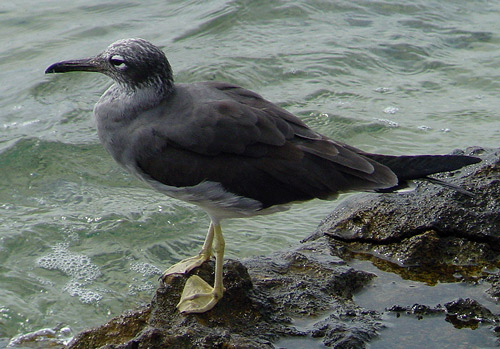 White-eyed Gull (L. leucophthalmus)
& Sooty Gull (L. hemprichii)
White-eyed Gull (L. leucophthalmus)
& Sooty Gull (L. hemprichii)
(last update:
White-eyed Gull L. leucophthalmus 3CY, February 21 2002, Shark Bay - Sharm El Sheik, S Sinai, Egypt.
Note the long and thin bill, slightly paler at the basal half on the lower mandible. It has two white crescents. In second winter, White-eyed Gull develops a blackish mask, extending as a solid black patch on the ear-coverts. The upper-parts appear grey, where Sooty Gull has brownish scapulars. Second winter birds show more white in the tail than first winter birds (which show a complete dark tail). In general, second winter birds resemble adults but lack the complete white tail and the hood is not fully developed, the chin and forehead still pale. The black second generation primaries have rounded tips. They miss the obvious white tips on the 5th and 6th primaries as can be found in adults and second winter and adult Sooty Gulls. However, the inner four primaries show small white tips. The second generation tail show variable amount of black, forming a broken tail-band. Some feathers appear all white, some have a black basal centre, creating a broken tail-band. All wing-coverts are at least second generation by February and pale brown juvenile feathers are absent. The first required wing-coverts appear slightly abraded and these feathers can be picked out by the brown-grey hue. The second generation tertials and wing-coverts are plain grey. The scapulars and mantle feathers generally have the same grey colour as the coverts but the upper scapulars show darker centres: a dark shaft and a dark wedge-shaped centre in some feathers. The rump is dull grey, not clean white as in full adult plumage. The breast-band is not plain grey as in adults but has some maculation or flecking on the lower throat, side-neck and extending further back to the nape. The legs are yellow.
